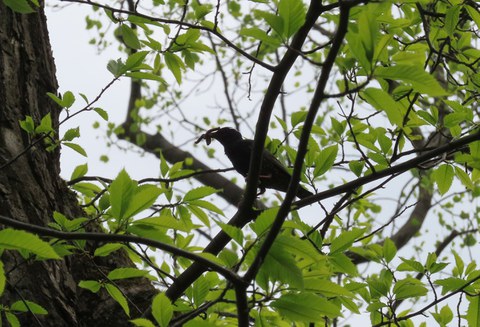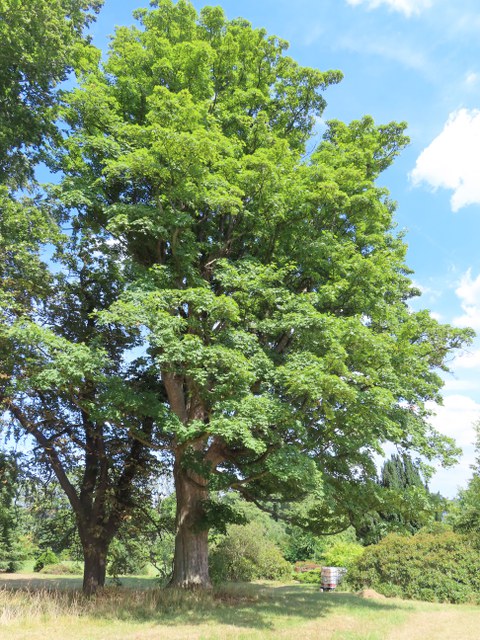Feb 16, 2024
The stories of the oldest inhabitants of the Eastern Ore Mountains: The "Old trees = habitats" project is online

A starling brings food to its breeding cave (American chestnut tree in the Forest Park Tharandt)
The stories that "the oldest inhabitants of the Eastern Ore Mountains" can tell are special - if you can read them. The almost 30-meter-high pine tree on the Harthaer Flügel, for example, is one of the oldest inhabitants and a witness to the eventful history of the Tharandt Forest. When it was planted, the deciduous forests in the area had already been severely devastated; it was deliberately left standing in order to ensure that pine trees would regrow on the cleared areas. Back then, the pine had more space for itself; later on, it was crowded out by the deciduous trees, which today can once again take possession of their natural habitats in place of the artificially created spruce and pine forests. The mighty sycamore maple in Naundorfer Park is not quite as old and is part of a historical landscape park. However, it is particularly impressive with its dense canopy of leaves and is home to many species of birds and bats.

Mighty sycamore in Naundorf castle park (Schmiedeberg)
From 2021 to 2023, members of the Chair of Biodiversity and Nature Conservation at TU Dresden collected these and many more tree stories from the Eastern Ore Mountains in cooperation with the Grüne Liga Osterzgebirge environmental association in the project "Old Trees = Habitats". Their first objective was to record the old and unusual trees, and to analyze their value for biodiversity and climate protection. The results are now available to everyone on the baumdenkmale.org website. The website contains information on the biology of the tree species as well as a treasure trove of data and information on the history of individual, particularly valuable old trees.
In addition to recording and evaluating the aesthetic and cultural value, and assessing the vitality and state of development, the researchers also recorded the habitat potential of the trees, which indicates whether the trees can provide a habitat for certain animal and plant species. For this purpose, the scientists looked for indications such as caves or other habitat structures. They also examined the epiphytes (moss and lichen growth) of numerous trees, as well as a selection of the birds, bats and insects found on and around the trees. They used laser scanning to capture the volume and growth form of selected trees in a detailed way and in three dimensions, enabling more precise calculations of the wood mass and the bound carbon and thus a more precise assessment of the climate protection potential. This will also allow for changes to be documented during subsequent investigations.
Moreover, the project focused on educational activities, such as the "Young Nature Guards" program, public lectures and exhibitions as well as excursions in the Eastern Ore Mountains nature reserve. Lectures on old trees are firmly anchored in TU Dresden's degree programs in forest sciences and spatial development and natural resource management.
A network of tree patrons was established beyond the end of the project. Numerous volunteers will take care of old trees, document their condition every year and keep an eye on their well-being, in particular for potential dangers, for example in the course of construction work.
"The work of volunteers, in particular, is an indispensable contribution to the protection of trees," Dr. Sebastian Dittrich, project member at the Chair of Biodiversity and Nature Conservation, is convinced. "Thanks to our research findings, we can show everyone who is interested a completely different side to trees; each tree is its own little world with special inhabitants and micro-habitats". To preserve these communities, proper care and protection of the trees is necessary to avoid shortening their lives unnecessarily. All too often, even trees with natural monument status are damaged, often through ignorance or negligence.
The tree project, funded by the Free State of Saxony as part of the "Sustainably out of the crisis" program, is only "a first step in the in-depth research of old and special trees", explains Antje Lindner, current project member at Grüne Liga Osterzgebirge (Dippoldiswalde). Another project - starting in April 2024 - in cooperation with the Comenius University of Bratislava and funded by the German Federal Environmental Foundation (DBU) will also record old trees in the Poľana Biosphere Reserve in Slovakia, with a particular focus on tree sponsorship by children and young people. This tree survey will be supported by the Chair of Biodiversity and Nature Conservation.
The proven cooperation between TU Dresden and the Osterzgebirge Green League will also be continued in the coming years - because "there are still old, large trees worthy of protection to be discovered in other natural areas," say Sebastian Dittrich and Antje Lindner.
More information: https://www.baumdenkmale.org/
Contact:
Dr. Sebastian Dittrich
Chair of Biodiversity and Nature Conservation
Mobile: +49 179 4168794
